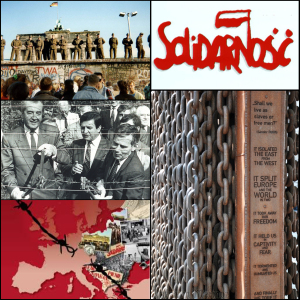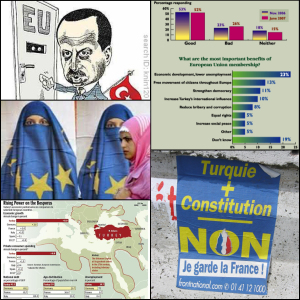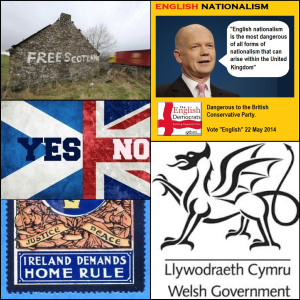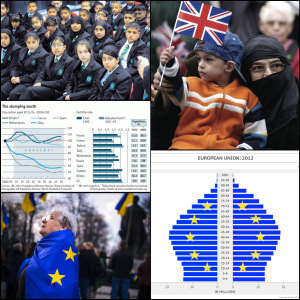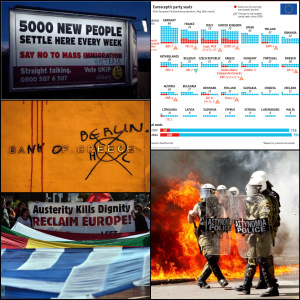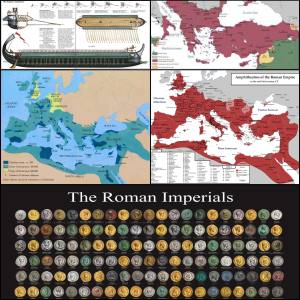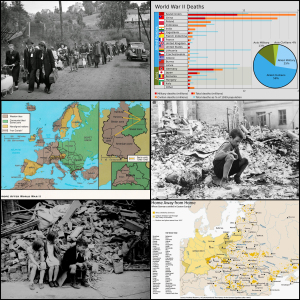These images all focus on the fall of the Iron Curtain in Europe in the late 1980s. The top right image is the logo of the Polish Solidarity union, which served as a catalyst in bringing down the Iron Curtain. Solidarity was not a part of the Communist Party, which was extremely unusual for a trade union in the Soviet sphere of influence. A huge portion of Poland’s population joined Solidarity, and it quickly became an opposition movement. In the early 1980s, the Polish government implemented martial law in an attempt to crack down on Solidarity’s popularity and criticism of the government. Eventually, the Polish government realized that Solidarity was too big to quash and was forced to negotiate. These negotiations led to elections that were partially free in 1989. In the 1989 elections, the Polish people voted resoundingly for Solidarity and against communism. After that, it was only a matter of time until the rest of Eastern Europe would follow Poland’s lead.
The middle left image shows Hungarian and Austrian officials bringing down part of the physical Iron Curtain. In the summer of 1989, the Austrians and Hungarians staged a “Pan-European Picnic” on their border, where they would temporarily take down the fencing separating East and West and let people cross back and forth freely during lunch. However, East Germans in Hungary also heard about the plans for the picnic and decided to take advantage of the opportunity. East Germans faced extremely heavy restrictions on travel to the West, but could travel much more freely behind the Iron Curtain, including to Hungary. On the day of the picnic, hundreds of East Germans arrived and crossed through the open border into Austria and the West.
The top left image shows East German soldiers standing on top of the Berlin Wall after the border between East and West Germany had been opened. After the Pan-European Picnic, thousands of East Germans were able to escape to Austria through Hungary. However, the East German government eventually caught on and banned travel to Hungary. After this, many traveled to Hungary (and then Austria) through Czechoslovakia or simply went to the West German embassy in Czechoslovakia. The East German government eventually decided to open the border between East and West Germany, but due to a miscommunication, border guards were completely uninformed. Masses of East Germans arrived at the Berlin Wall on November 9, 1989 wanting to leave, but faced resistance from the guards. Eventually, the guards gave in and opened the border, ending the physical separation of West and East Germany.
The bottom right image shows an Iron Curtain monument in Budapest, which serves as a reminder of the terrible times of the Iron Curtain. For people in Eastern Europe, the Iron Curtain isolated them, separated them from the West, oppressed them, and humiliated them. However, the people who lived behind it did not simply accept its presence. They fought to tear down the Iron Curtain, and they were ultimately successful. Europe is no longer divided between East and West, and many of the countries that used to be behind the Iron Curtain have now joined the ultimate Western club – the European Union.
EUST Blog #5
Although Turkey’s path to membership in the European Union began decades ago, the topic is still quite controversial within the EU and within Turkey itself. The top left image is a cartoon, which shows Turkish President Erdogan knocking at the door to the European Union, waiting to be admitted. Behind the door, a set of eyes (representing EU member states) peers out, hoping that Erdogan and Turkey will eventually stop knocking and leave them alone. While some EU member states are less than thrilled about the idea of Turkish accession, I believe the cartoon is problematic in its presumption that all EU members feel the same way about this issue (or any issue). The EU is composed of 28 members, and they ‘fight’ about almost everything, including Turkish accession. Furthermore, if all of the EU was really so against Turkish accession, they would not have let Turkey even start the accession process, but would have instead turned it away, like they did with Morocco.
The top right image shows how Turkish opinions about the EU have changed. Although the data is not very current, I would imagine that the trends shown have continued to the present day, i.e., the percentage of Turks who view the EU as good has probably continued to decline, and the percentage of Turks who view the EU has bad has probably continued to increase. By far, Turks see economics as the primary benefit of joining the European Union. However, the EU (and much of the world) has experienced massive financial problems since 2008. The Turks have witnessed first hand how the EU and national politicians responded to these problems by implementing austerity measures in Greece, Spain, Italy, etc. When the economy of the EU is not doing so great, and the main reason to join the EU is because of economic benefits, it causes the Turkish people to question the value of joining.
The bottom left image shows many of the reasons why the EU might want Turkey to join, some of which are economic. Although the year is not given, the data must be from sometime between 2007 and 2013 because EU 27 is listed under “Private Consumer Spending.” Turkey’s economy and private consumer spending are both growing at significantly faster rates than the listed EU members. Its national debt compared to GDP is much lower, the population is younger, and the unemployment is similar to the given EU members. Combined, these data mean that Turkey could serve as an economic engine within the EU. The Turkish population is young and buying things. By admitting such a quickly growing economy, the EU could help improve its own economy as a whole.
However, Turkey faces major obstacles on the path to accession, especially in France and Austria. The lower right image shows a Front National poster in France asking the people to vote no on Turkey and the EU Constitution. France recently passed a law that required a popular referendum on new EU members. Since then, the law has been altered to only require a supermajority of Parliament. Around the same time, Austria also passed a law requiring a popular referendum. With these laws on the books, it is essentially impossible for Turkey to complete the accession process and become an EU member state.
Geography of Europe Blog #4
The dissolution of the Soviet Union was undoubtedly one of the most important geopolitical events of the twentieth century. Not only did it end the Cold War, but it also brought the world from a two-superpower system to a one-superpower system, which has had many long-lasting effects. The fall of the Soviet Union did not happen overnight, however. A chain of events beginning with the Soviet invasion of Afghanistan, also known as the Soviet Union’s Vietnam, set the USSR on the path to its ultimate demise.
The Soviet Union invaded Afghanistan in the very end of the 1970s in order to support the newly installed Afghan communist regime. Like the US in Vietnam, the USSR wanted to support a government that shared its ideology against an opposition force that did not. Also like the US, the USSR stayed in Afghanistan for a long time and lost many soldiers. During this period, Mikhail Gorbachev came to power as leader of the Soviet Union and quickly began implementing major reform policies within the Soviet Union’s domestic and foreign politics. Gorbachev implemented the reforms of glasnost and perestroika at home, pulled out of Afghanistan, and fostered closer ties with Western leaders and states.
Throughout 1990 and 1991, the Soviet Union began to fall apart. As the Time cover shows, countries within the USSR began to demand independence. Some of them were able to successfully break away and establish themselves as independent countries. In August 1991, communists in Moscow staged a failed coup in an attempt to stop Gorbachev’s liberalizing reform policies. The top left image shows people in Moscow taking down a statue after the failed coup.
In December 1991, the Soviet Union finally came to an end. Russia, Belarus, and Ukraine established the Commonwealth of Independent States early in the month, declaring that the Soviet Union was “ceasing its existence.” A few weeks later, most of the Soviet republics joined the CIS at Alma Ata. The map in the bottom left shows the successor states of the Soviet Union. Before the New Year, only one superpower was left in the world, and geopolitics would be permanently altered. The red Soviet flag (shown with the hammer and sickle cut out in the middle-left image) was replaced by the Russian tricolor.
Three of the former Soviet republics quickly pivoted away from Russia and towards Europe. Estonia, Latvia, and Lithuania began the process of accession to the European Union, and joined in 2004 as part of the Ten. Ukraine has tried to get closer to both Europe and Russia, which has caused considerable conflict in the past year, including the Russian annexation of Crimea and the shooting down of flight MH17.
Since the fall of the Soviet Union, Russia has enjoyed much more power than any of the other CIS members, although it is much less powerful than the Soviet Union was. Until recently, Russia’s economy had been growing quite robustly, and it was included in the BRICS group of strong developing economies. However, Russia now faces an economic crisis due to the ruble’s value collapsing. Going forward, Russia must try to stabilize its economy instead of grandstanding on the global stage.
EUST Blog #4
These images all deal with Cyprus, which has become one of the largest obstacles on Turkey’s path to EU accession, especially after the accession of the Republic of Cyprus to the EU in 2004. Cyprus has a long history and has been controlled by many different powers, from the Byzantines, to the Crusaders, Venetians, Ottomans, and British. This historical diversity of control has led to Cyprus having a non-homogenous population in the modern day. Before the island was divided in the 1970s, the Cypriot population was largely Greek Cypriot, with pockets of Turkish Cypriots scattered across the whole island, as can be seen in the top-left image.
During the early days of its independence in the 1960s, the Cypriot government was supposed to implement a power-sharing plan, where Greek and Turkish Cypriots would both have power. However, the Greek Cypriots almost immediately began making changes to give themselves more power and exclude the Turkish Cypriots from the government. Many Greek Cypriots, including the EOKA-B, longed for enosis, or unification with mainland Greece. A coup in 1974 created the Hellenic Republic of Cyprus, with the goal of annexation by Greece. A few days later, Turkey invaded Cyprus in response to the coup, which had supposedly been supported by Greece, thus violating the Treaty of Guarantee, which prohibited such intervention. Turkish troops, like the ones in the bottom left image, eventually captured about one-third of the island and created a green line between the Turkish and Greek sections of the island. The Turks established the Turkish Federated State of Cyprus on their half of the island, which would later become the Turkish Republic of Northern Cyprus.
UN peacekeepers like those in the middle-left image have been present in Cyprus for decades. Before the coup and Turkish invasion, UN peacekeepers arrived to prevent violence after the implementation of the Akritas Plan in 1963, which removed all Turkish Cypriots from the government. Since the division of the island into the Greek Cypriot Republic of Cyprus in the south and the Turkish Republic of Northern Cyprus, the UN has administered the buffer zone (shown in the two right images) between the two halves of the island.
Historically, travel between the Republic of Cyprus and TRNC has been extremely limited. In recent years, however, there has been an increase in Cypriots crossing over to the other side of the island. Some Greek Cypriots have begun to make claims on the property that they abandoned after the Turkish invasion forced them south in 1974.
Prior to the Republic of Cyprus’ EU accession in 2004, the EU required them to implement the Annan Plan to settle the dispute between the Greek and Turkish Cypriots. The plan would have created a federation, settled property claims (and compensated property owners), and demilitarized the island. In a referendum, the Turkish Cypriots approved the Annan Plan, while the Greek Cypriots overwhelmingly rejected it. Because the referendum was conducted so close to the official EU accession date, the EU let Cyprus enter as a single unit, but with the acquis communautaire suspended in the north. In order for Turkey to join the EU, the Cyprus issue must first be fully and successfully dealt with.
EUST Blog Assignment #3
The top three images all deal with reforms introduced by Mustafa Kemal Ataturk as part of his plan to modernize Turkey after the establishment of the Republic. Ataturk reformed nearly every aspect of the Turkish government and society in order to bring it up to the standards of a 20th century western nation. Perhaps his most important reforms were educational. The quote in the top right image shows how Ataturk believed that teachers held a crucial role in implementing his reforms. Without teachers, future generations would not be educated, and Turkey would fall further and further behind other countries. Ataturk’s educational reforms included the introduction of compulsory secular education with an emphasis on science. Ataturk also reformed madrassas, which became significantly less important in Turkey. Perhaps the most important educational reform implemented by Ataturk was the Turkish language’s switch from Arabic to Latin script. The textbook pages in the middle left show how this change was executed. The Turkish state desperately wanted to increase its literacy rates, so it paid for books and classes for all citizens (not just schoolchildren) to learn the new writing system. In just a few years, Turkey’s literacy rate rose from 10% to 70%.
Ataturk reformed other parts of Turkish society, not just the education system. He adamantly believed in the importance of secularism in society, much like the French tenet of laicite. Part of implementing secularism in Turkey included changing the style of dress. Traditionally, Turkish dress included standard Muslim garb, like the turban and hijab, along with the very Ottoman fez. Ataturk banned all of these and encouraged Turks to wear modern western clothes. In the top left image, you can see Ataturk and other Turks wearing three-piece suits and western-style hats. In order to become a modern country, Turkey had to look the part.
The bottom right image shows the invasion plan for Gallipoli. The Allies invaded the Gallipoli peninsula in an attempt to take control of the Dardanelles during World War I. However, poor planning and disease made the campaign drag on from April 1915 all the way until January 1916. Both the Allies and the Turks suffered massive casualties totaling around 250,000 for the British and French and 220,000 for the Turks. Gallipoli ended up being very important in Turkish history because the successful Turkish defense was organized by none other than Mustafa Kemal Ataturk. This helped bring him national prominence and admiration, which later helped him become the leader of the new Turkish Republic.
The bottom left image shows a map of Turkish territory established by the Treaty of Lausanne (1923). The Treaty ended the conflict between Turkey and the Allied powers of WWI. It guaranteed Turkish sovereignty and recognition. The Treaty caused Turkey to lose some Ottoman territories, including Cyprus, Egypt, Sudan, Thrace, the Dodecanese Islands, and Sudan. Essentially, the Treaty of Lausanne created the borders of modern Turkey. There was also an exchange of Greek and Turkish populations; 1.5 million Christians left Turkey for Greece and 500,000 Muslims left Greece for Turkey.
Geography of Europe Blog Assignment #3
These images all deal with nationalism across the British Isles. Although nationalist movements have existed to some degree within Great Britain since the integration of Wales, Scotland, and Northern Ireland into the English/British government, they became much more prominent beginning in the 19th century. Today, the Scottish nationalist movement is by far the most visible and well known across the world. Although Scotland, Wales, and Northern Ireland all have devolved parliaments and powers, the Scots have been particularly vocal in their desire for more. In 2014, this culminated in an independence referendum in Scotland.
Many Scots view the British government in a particularly negative light. Even with the devolved Scottish Parliament, Westminster still wields many powers over the country. For example, the British nuclear arsenal is located in Scotland, against the wishes of numerous Scots. Additionally, Scotland has natural resources such as oil, but most of the money does not stay in Scotland. Therefore, some see the British government as almost oppressive, and they want freedom, as shown in the top left image.
The middle left image shows the Scottish and British flags, both of which were used frequently in the run-up to the Scottish independence referendum in 2014. A “yes” vote meant an independent Scotland, while a “no” vote meant remaining a part of the United Kingdom. In the weeks leading up to the referendum, opinion polls began shifting toward the “yes” vote, and Westminster politicians went into panic mode. They promised Scotland “devomax” or full devolution to Scotland. This would grant the Scottish Government much greater powers than it held at the time. This promise helped ensure that the “no” vote won the referendum. However, since the referendum, Westminster has seemed to get cold feet about granting Scotland devomax. Scottish nationalist sentiment has only increased since the defeat of the referendum, as has support for the SNP, which looks like it may have record-breaking results in the next general election in May. Furthermore, David Cameron has promised a UK-wide referendum on exiting the EU if the Tories stay in power after the general election. If he keeps his promise, and the UK votes to leave the EU, the Scots will probably be more pissed off than they have ever been. Scotland is completely committed to the EU, and would likely separate from the UK if the UK chose to leave.
Wales has been joined to England longer than Scotland has, which has given it more time to integrate with England. Nationalist sentiment in Wales, therefore, is much weaker than in Scotland. Wales also does not have significant natural resources like Scotland does. Plaid Cymru is the Welsh nationalist party that promotes Welsh independence, but it does not enjoy as much support as the SNP does in Scotland. Wales seems to be content with the current amount of devolution it has in the Welsh Government.
English nationalism also exists within the United Kingdom, but it is quite limited, probably since England holds the majority of the power within the British government. There simply is not a need for an English government, since the British Government is essentially an English government. English nationalism does exist, however, and is promoted by the English Democrats, who have 1 seat on the Boston Borough Council, and no seats in any other government body.
Europe Blog Assignment #2
These images reveal many of the social and demographic changes that have occurred in Europe recently. The EU is currently at a fork in the road; it must decide whether it wants to make the effort to integrate all European people into the European project, or whether it wants to remain a Christian club for the foreseeable future. Clashes between white, Christian Europeans and Muslim Europeans have become more and more visible in recent years. For example, media coverage of the Charlie Hebdo attacks in Paris dominated global headlines for weeks. The increasing visibility of these clashes begs the question: Can the EU and Islam peacefully coexist?
The answer, obviously, depends on who you ask. Far-right political parties like Farage’s UKIP and Le Pen’s Front National preach that immigrants, especially Muslim ones, pose a lethal threat and are the root cause of their countries’ problems. This is blatantly untrue. France and Britain would clearly still have problems, even if they were 100% homogenous. However, these parties feed on the fear they create through othering, and have been quite successful so far.
The truth, however, is that there are far more Muslims in Europe that consider themselves European (or British, or French, etc.) than there are who want to bring down Western society. Children in schools such as the Waterhead Academy, which is largely divided between white and Pakistani students, have proven this. Although the students may come from vastly different backgrounds, they can come together at school to learn and share life experiences together. Immigrant youths in Britain tend to be integrating more quickly and completely into British society than their elders, but that does not mean that older immigrants remain completely separate from European societies (Goodhart). Just like their children, they can integrate into society while still maintaining their own cultural traditions, as shown by the burqa-clad woman holding a child, who is waving a British flag.
On its own, the population of Europe is rapidly aging. The baby boom of 1945-1975 is over, and fertility rates have decreased to below replacement levels in most countries. Now, there are large numbers of older citizens depending on a dwindling number of working age adults. Most of the (small) overall population growth in Europe can be attributed to immigration. Immigrants come to Europe to improve their lives and give their children a chance at a better life. These children raised in Europe could help the continent overcome the problem of its rapidly aging population since they will grow up invested in the success of their home. However, if Europeans continue to be xenophobic and push them away, many immigrants may look elsewhere.
Regardless of the demographic and social situation in the EU, many outside the Union still see it as the prime example of international cooperation. The economic and political benefits of being in the EU are clear, which leads many, like people in western Ukraine, to push for their countries to join. Whatever problems may come with membership, they see it as better to be in the club than out of it.
Works cited
Goodhart, David. “A Very British School.” Prospect Magazine May 2013. Web. 22 Feb. 2015. http://www.prospectmagazine.co.uk/features/waterhead-academy-oldham-integration-david-goodhart.
Here is the next blog exercise. Remember 500 words, on topic and relevant and please use paragraphs. Due by midnight on Sunday the 22nd.
EUST Blog Assignment #2
Popular opinion regarding the EU has changed quite a bit in the past 5-7 years. The global financial crisis, and especially the Eurozone sovereign debt crisis, caused massive economic problems across the EU, which caused financial hardships for many citizens. In the wake of these economic issues, the European Union bailed out some particularly troubled countries, like Greece. However, these bailouts required the countries to implement harsh austerity measures, which included raising taxes and decreasing government spending (which meant a decrease in services). Unsurprisingly, the austerity tactics proved extremely unpopular. No one wants to pay more in taxes in return for fewer government services.
The negative sentiment towards the EU has been by far the most visible in Greece. The Greek people have rioted and protested against the austerity measures imposed by the EU and the ECB. Because the ECB is so heavily influenced by the policies of the Bundesbank, much of the Greek anger has been expressed towards Germany, as well as the EU itself. After too many years of austerity, the Greek people recently took matters into their own hands and elected the far-left party Syriza into power. Syriza and the new Prime Minister Alexis Tsipras have promised to end the austerity measures in Greece and to renegotiate the unfavorable terms of the bailouts.
The backlash against austerity is not unique to Greece, however. In Spain, the left wing party Podemos (We can) has established similar goals as Syriza and has become the second-largest party in Spain in less than a year, behind only the center-right PP. Both Syriza and Podemos also share a soft eurosceptic ideology, and therefore are not included in the eurosceptic party seats chart.
Across the EU, negative feeling toward the Union has not come only from economic concerns. Many, especially in Western Europe, are more concerned with immigration into their countries, especially from the eastern parts of the EU, Turkey, and the Middle East. Some people believe that immigrants will never integrate into their new country’s society and will slowly destroy society itself. Many eurosceptic parties feed on this xenophobic fear of immigrants and have been quite successful. UKIP, for example, is both strongly anti-immigrant and eurosceptic. In the 2014 EP elections, UKIP won more votes than any other party in the UK; this was the first time in over a century that neither the Tories or Labour won the most votes in a nationwide election. Furthermore, UKIP won its first seat at Westminster late last year in a by-election.
It is interesting to note in the eurosceptic party seats chart that most of the strongly eurosceptic countries acceded to the EU prior to 2004. Of the 13 countries that have joined the EU since then, only three (Lithuania, Poland, and Hungary) elected any strong eurosceptics to the EP in 2014, and of those three, only one (Poland) elected more strong eurosceptics in 2014 than in 2009. The chart reveals that most of the new EU members are happier with the Union than the older members. The new members as a whole are poorer than the older ones, which means that they are getting more benefits from membership, while the older members are seeing their benefits decrease. Therefore, the older members are starting to question the value of being a member of the EU. Perhaps the EU is entering a new period of political eurosclerosis.
Here is the next blog exercise. Remember 500 words, on topic and relevant and please use paragraphs. Due by midnight on Sunday the 22nd.
Europe Blog Assignment #1
These images give a brief overview of the classical period in Europe, including the Greek Empire, the Roman Empire, and the Byzantine Empire. Each of these empires had their own respective strengths, which allowed them to dominate the Mediterranean region for centuries.
The Greek Empire would not have been possible without the development of shipbuilding. Ships allowed the Greeks to trade, travel, build colonies, go to war, etc. Warships, like the trireme and the Hepteres/septireme shown, were crucial to Greek dominance of the Mediterranean. Ancient Greek civilization depended on water for transportation because they did not yet have the technology to build inland transportation networks. This also helps explain why ancient Greek civilization for the most part did not spread very far into the interior of the continent, as Rome did. The colonies established by the Greeks served to export surpluses of goods like olive oil, metals, and luxury items to the main Greek cities. Greek elites had leisure time, which allowed the civilization to develop the rich culture that it is known for today.
Like the Greeks, the Roman Empire began its history with sea trade across the Mediterranean in the 1st-2nd centuries BCE. The Romans gradually took over the Greek colonies and expanded their territory. Rome, however, had key advantages over the Greeks that allowed it to spread quickly and across vast distances. Roman Emperors focused on military technology/organization and civil engineering, which allowed Rome to gain huge amounts of power and land. Roman engineering is still famous to this day; many Roman ruins, roads, and infrastructure stand to this day. The high quality Roman roads allowed Rome to spread inland (unlike the Greeks), and high quality construction allowed them to build sturdy buildings, like amphitheaters, with ease. The map of Roman amphitheaters, however, shows that there was an extremely high concentration of amphitheaters in the center of the Empire, with very few on the outskirts. Amphitheaters undoubtedly served as reminders of Rome’s power, but they were few and far between on the outskirts of the Empire, where such reminders were needed most. Rome faced many challenges due to its rapid expansion, which caused organizational and bureaucratic headaches for the Empire. Furthermore, the Empire became politically unstable with a rapid succession of Emperors, especially after the split of the Empire and the introduction of the Tetrarchy. The rise of Christianity as shown in the map further weakened the Empire by introducing a new religion that went against traditional Roman religion.
The Byzantine Empire tried to reclaim the glory of Rome, but ultimately failed. Under Justinian, the Byzantines tried to reclaim the Western Roman Empire, but were unsuccessful. The Byzantines became entangled in the Crusades, which did not work out very well for them. They faced constant pressure from the increasingly powerful Ottomans in Anatolia and were constantly pushed back until the Ottomans finally captured Constantinople in 1453. Although many overlook the Byzantine Empire, it did manage to hang around on its own for about 1000 years, which is quite an impressive feat in history.
This is your first blog assignment. Please write 500 (or more) words commenting on what you see in this post and how it relates to the material that has been covered in class. Please make sure that your comment can be easily identified (ie. use a username that is close to your own name or sign the post at the bottom). Feel free to comment on each other’s entries.
EUST Blog Assignment #1
These images reveal the devastating effects that World War II had on the European continent. A few of the images reveal the massive physical destruction that occurred due to bombings and other military offensives, while others reveal the effects of the war on European populations.
The middle right and bottom left images are the hardest to look at, since they reveal the effects of the war on Europe’s children. Many people often fail to consider the effects of war on children, and only think about the adults. The bottom left image shows children from London sitting in rubble that used to be their home until the Nazis bombed it during the Blitz. During World War II, the British implemented a major evacuation of children away from major cities (especially London) and other targets into the countryside to keep them safe from Axis bombs. The middle rights image shows a young boy among the rubble in the aftermath of the bombing of Warsaw in 1939. Unfortunately, this image foreshadows the massive effects that the war will have on the entire continent.
The rest of the images all deal with the aftermath of World War II. The top left and bottom right images both depict the expulsion of Germans from areas that had been a part of the Third Reich, but were taken away from Germany at the end of the war. Germans remaining in these territories, like the Sudetenland, were forced to leave and return to Germany after the conclusion of the war. As the map shows, Germans had spread across much of Eastern Europe in the early 20th century and therefore had a long journey ahead of them at the conclusion of World War II. It would be interesting to see a follow up to this map showing the distribution of Germans across Eastern Europe today to see how many of these German communities (if any) remain today.
The chart in the upper right shows the extreme effects of World War II on European populations. European countries tended to have higher percentages of their populations die in the war than other countries. Allied countries also accounted for 83% of deaths during the war, compared to the 17% for Axis countries. The Soviet Union had the largest number of deaths overall, but Lithuania lost the largest percentage of its population in the war. Had the Allies not had the Soviet Union available to willingly absorb so many deaths, it would have been much more difficult for them to win the war.
The map on the middle left shows the routes taken by western planes during the Berlin Airlift. After the Soviets cut off ground access to West Berlin in an attempt to starve it and eventually take it over, the British, French, and Americans began bringing supplies into West Berlin by air. The western countries were eventually successful and the Soviet Union unblocked ground routes into West Berlin. The Berlin Airlift served as a foreshadowing of the Cold War, which would dominate the continent and the world for the rest of the century.
This is your first blog assignment. Please write 500 (or more) words commenting on what you see in this post and how it relates to the material that has been covered in class. Please make sure that your comment can be easily identified (ie. use a username that is close to your own name or sign the post at the bottom). Feel free to comment on each other’s entries.
